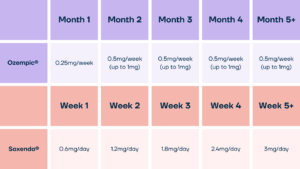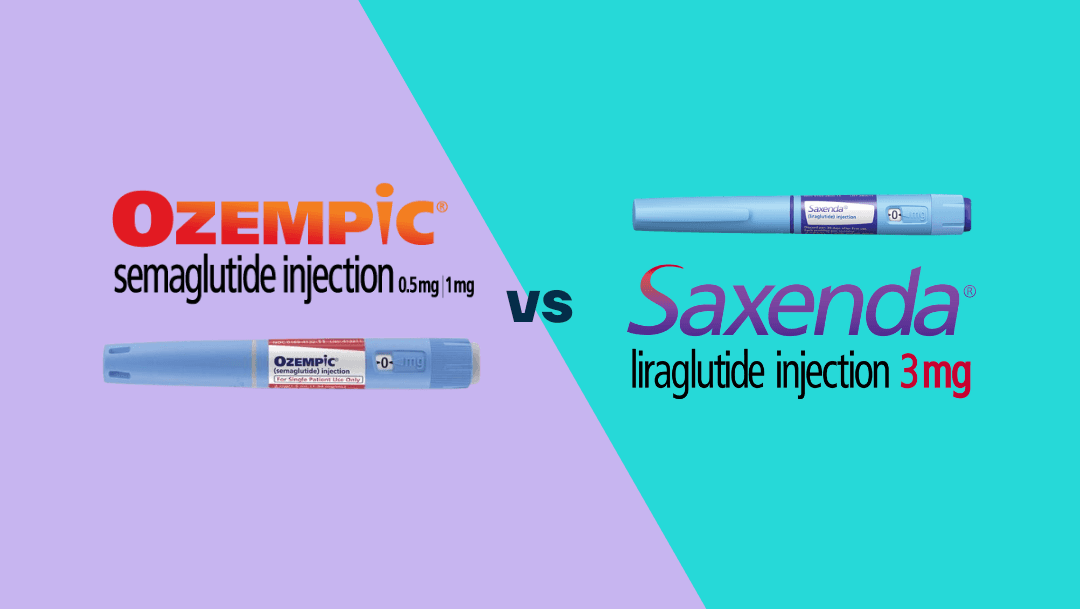Jump to: What are Ozempic and Saxenda? | Do you lose more weight on Ozempic or Saxenda? | Ozempic vs Saxenda | Take home message
Ozempic and Saxenda are GLP-1 receptor agonists, a class of medications from the pharmaceutical company Novo Nordisk that reduce appetite to help manage blood sugar levels and support weight loss.
The drug in Ozempic is semaglutide, and liraglutide in Saxenda. GLP-1 receptor agonists improve insulin function to lower blood sugar levels and delay gastric emptying, decreasing appetite.
Wegovy, contains the same drug as Ozempic but in higher doses, supports more weight loss than Ozempic and Saxenda and is available as part of our Wegovy weight-loss programme. We’ve also launched a Mounjaro weight-loss programme.
Semaglutide is a long-acting medication injected once a week, while ligarglutide is a short-acting medication injected daily.
Ozempic and Saxenda lead to similar levels of weight loss, around 6-8%, after one year.
However, studies have also shown that Ozempic leads to fewer side effects and adverse events than Saxenda, with people tolerating Ozempic better.
So, if you’re looking for a GLP-1 receptor agonist to help you lose weight and improve your blood sugar levels, Ozempic might be the better option.
However, individual responses to medications vary between individuals. Be mindful of side effects and contact your healthcare team to determine the appropriate medication and dosage.
Ozempic has been approved for use in the UK and FDA-approved in the U.S. as a medication for type 2 diabetes. It improves insulin action to manage blood sugar levels alongside its positive effect on appetite.
Saxenda is approved for individuals living with obesity to help them eat fewer calories and lose weight. You’ll also experience improved glycemic control due to the effect of GLP-1s on insulin function.
One of the main differences between Ozempic and Saxenda is the dosing schedule.
Both drugs are self-administered injections, but Ozempic is administered once a week and Saxenda once a day.
Ozempic and Saxenda dosing schedules:

Saxenda is available to purchase in the UK and U.S. and via prescription from your GP in the UK.
Ozempic is available to purchase in the U.S. and UK and via prescription from your GP in the UK if you have a high BMI and are at risk of type 2 diabetes.
Wegovy and Mounjaro are the two most effective weight-loss injections available in the UK and are available alongside Second Nature’s weight-loss programme.
Medication-assisted weight loss with a future focus
Start with Wegovy or Mounjaro, transition to habit-based health with our support


1) What are Ozempic and Saxenda?
When we eat food, our stomach releases a hormone that helps the body regulate hunger and blood sugar levels. This hormone is called GLP-1 (glucagon-like peptide-1). The actions of GLP-1 are the target of Ozempic and Saxenda.
This class of medications are known as GLP-1 receptor agonists (GLP-1s). They mimic the actions of the hormone GLP-1.
GLP-1s help your pancreas release more insulin to lower blood sugar levels, delay emptying food from the stomach (also called gastric emptying), and reduce appetite via a mechanism in the brain.
There are two well-known GLP-1 medications available in the UK and U.S.:
- Liraglutide (Saxenda): Taken once a day.
- Semaglutide (Ozempic and Wegovy): Taken once a week.
Do GLP-1 receptor agonists work?
Clinical trials have demonstrated that GLP-1s are more effective at weight loss than other weight loss medication drugs like orlistat, which has a different mode of action for weight loss and lowering BMI (body mass index).
A systematic review and meta-analysis (a study analysing lots of different studies) analysed 28 trials in over 29,000 people investigating the effectiveness of five weight loss medications on weight loss.
The study found that all five medications were more effective than the placebo at supporting weight loss.
This trial included orlistat and the GLP-1 liraglutide and found that liraglutide was more effective at weight loss than orlistat and showed that participants taking liraglutide were twice as likely to achieve more than 5% weight loss than orlistat.
Due to the relationship between obesity, blood sugar levels, and cardiovascular disease, research shows a positive relationship between GLP-1s and heart disease risk factors such as high blood pressure (hypertension) and triglyceride levels.
Interestingly, more recent studies have shown that semaglutide (Ozempic and Wegovy) is more effective at supporting weight loss and type 2 diabetes than liraglutide (Saxenda).
It’s not recommended for pregnant women or individuals with a family history of thyroid cancer to take GLP-1s.
Key points:
- GLP-1 receptor agonists (GLP-1s) are a class of medications that mimic the actions of the hormone GLP-1, which helps regulate hunger and blood sugar levels.
- GLP-1s help the pancreas release more insulin, delay stomach emptying, and reduce appetite.
- Two well-known GLP-1 medications in the UK and U.S. are liraglutide (Saxenda) and semaglutide (Ozempic and Wegovy).
- Research has suggested that GLP-1s are more effective at supporting weight loss than other weight loss medication drugs like orlistat.
- A systematic review and meta-analysis found that all five weight loss medications investigated were more effective than placebo at supporting weight loss.
- Liraglutide was more effective at weight loss than orlistat. Semaglutide is more effective at supporting weight loss and type 2 diabetes than liraglutide.
2) Do you lose more weight on Ozempic or Saxenda?
Research suggests that the average weight loss on Ozempic is similar to Saxenda.
Data from randomised controlled trials on Ozempic (semaglutide 1 mg) showed that average weight loss ranged from 6% to 8%.
Similarly, a randomised controlled trial on Saxenda (liraglutide 3 mg) showed it supported an average weight loss of just over 8% after one year.
However, research suggests that semaglutide is generally better tolerated than Saxenda.
Up to 30% of participants on Saxenda tend to stop the medication due to adverse side effects, compared to around 12-13% on Ozempic.
So, while weight loss on Ozempic may be similar to Saxenda, you may be able to tolerate it better and stay on the medication.
Key points:
- Research suggests weight loss on Ozempic and Saxenda is similar
- However, more people tend to stop taking Saxenda because of side effects than Ozempic
3) Ozempic vs Saxenda
Effectiveness
Ozempic and Saxenda generally support similar weight loss and blood sugar improvements. However, Ozempic seems to be better tolerated.
So, if you were looking for a GLP-1 medication, Ozempic may be the better choice. Although, you can only get Ozempic if you’re living with type 2 diabetes in the UK.
Side effects and safety
Ozempic seems to be a better-tolerated drug than Saxenda. As discussed above, in a randomised controlled trial comparing the two, 50% more people discontinued their treatment due to the side effects of Saxenda compared to Ozempic.
Still, over 80% of individuals taking both medications can expect to experience severe and mild side effects like nausea, constipation, and cramping.
However, the discomfort from these side effects appears greater with Saxenda than with Ozempic.
Individual responses to medications vary significantly. Some people might do well on Saxenda but not on Ozempic (and vice-versa).
It’s essential to weigh the pros and cons of your medication and report any side effects to your healthcare team.
Cost
Saxenda
The cost depends on where you’re purchasing it from and how long you intend to use the medication. However, to purchase the medication and injectable pens required for 56 days would cost £323.99, or around £160 per month.
The price would then increase incrementally the longer you use the medication. Saxenda is generally recommended for up to 12 weeks, costing anywhere between £485-£540.
Saxenda is available on prescription in UK pharmacies if you’re eligible.
Ozempic
The cost depends on where you’re purchasing it from and how long you intend to use the medication.
However, to purchase the medication and injectable pens required for four weeks would cost around £126, or around £1520 per year.
Ozempic is available on prescription in UK pharmacies if you’re eligible and are living with type 2 diabetes.
Key points:
- Ozempic and Saxenda lead to similar levels of weight loss
- Ozempic seems to lead to fewer side effects and is better tolerated than Saxenda
- However, individuals will vary in their response to medications, so choose the right one for you
- Ozempic and Saxenda are both available on prescription in the UK if you’re eligible
- Both medications are expensive if you opt to purchase them privately
Take home message
Weight-loss injections are designed as additional tools for weight management interventions and shouldn’t be considered lifelong medications.
Instead, they should be used to help you kickstart your weight loss and healthy journey while you commit to living a healthier lifestyle.
Consider the use of antidepressants for people living with depression. They’re not designed to cure the condition. Instead, they’re designed to allow room for therapy to treat the condition’s underlying cause.
Mounjaro, and other weight loss injections, like Ozempic and Wegovy, are similar. They can allow you to make lifestyle changes to support long-term weight loss maintenance.
Mounjaro can help silence food-related thoughts and also give you a boost of confidence with more immediate weight-loss results.
This helps to buy you the time and headspace to understand why your body may have struggled to lose weight previously, and to build new long-term healthy habits.
The core focus of our medication programmes is to calm down the feeling of food noise, lower your cravings, and allow you to build healthier habits to keep the weight off for good.
The ultimate goal is to make losing weight feel second nature.
Second Nature’s medication programme
Second Nature currently provides Mounjaro as part of our Mounjaro weight-loss programme.
Why should you choose Second Nature over other medication providers if you’ve decided to try Mounjaro (assuming you’re eligible)?
For peace of mind.
Second Nature has worked with the NHS for over 6 years providing weight-loss programmes across the UK.
While our Mounjaro weight-loss programme is private and not currently used by the NHS, we’ve built the programmes focusing on scientific evidence, patient safety, and data security.
We hope that our 6+ years of working with the NHS and building a track record of effective weight-loss results will give you peace of mind to give us a try.
Medication-assisted weight loss with a future focus
Start with Wegovy or Mounjaro, transition to habit-based health with our support



Maximise your weight loss on Mounjaro with our free 7-day meal plan
Get expert advice from our team of registered dietitians to make losing weight feel easier while on medication. Subscribe to our newsletter to get access today.

